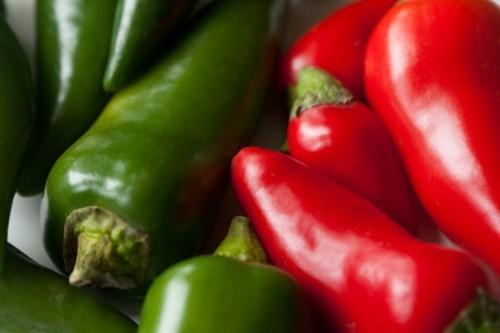Unused stories
Growing In Your Garden Now - Peppers
Add some spice to your life with hot peppers...

Peppers, Capsicum annum
Peppers, members of the Solanaceae family, are found in the warmest parts of the world. A perennial ranging in taste from the hottest habaneros to the sweetest bells, the “hot” agent comes from capsaicinoids primarily found in the tissue like membrane surrounding the seed.
Peppers need daytime temperatures of 65 to 85?F and do not like nighttime temperatures below 65?F. Variations may cause blossom drop and immature fruit. Soil temperatures below 50?F will cause root dieback. Accordingly, in Marin, the best planting date is after June 1st. Peppers grow very slowly and harvest is usually 60 to 80 days out. Blooms after the end of August usually do not mature. When temperatures approach 100?F, pollination, fruit set and yield are reduced. Peppers depend on wind for pollination and get helped along by bees and other vibrating insects. In sheltered locations, gardeners sometimes tap branches to insure complete fertilization. Pollination also requires humidity between 60% and 80%. Dry air causes pollen to dry out and moist air doesn’t allow the pollen to fertilize the flower completely.
Just like tomatoes, peppers like soil with a pH range from 6.5 to 7.0 but they require more sun and nitrogen than tomatoes. Before planting, amend the soil with a nitrogen rich manure and side dress with fish emulsion or cow manure at fruit set. For good plant development, do not plant from seed unless you have a greenhouse or hotbed with exposure to sunlight. Be forewarned, it takes seven to ten weeks from sowing to produce transplants. Rather, you may choose to plant purchased seedlings four to six inches tall with healthy green leaves. Do not select seedlings with flowers or fruit on them. If you do, those plants are not as likely to develop good root systems after transplanting. As with tomatoes, do not handle the stems when transplanting. Hold only the leaves and space the plants 12 to 24 inches apart depending on variety. Pinching off the tip of the pepper plant at planting encourages more side branches and fruit.
Peppers like soil kept evenly moist and water is important from fruit set through full fruit development. In the edible landscape, peppers are very attractive plants. To avoid breaking branches, harvest peppers by clipping the stem. Most peppers turn from green to red or yellow when fully ripe. Interestingly, red peppers have twice as much vitamin C as green or yellow peppers. To save seed, pick only red, fully ripe peppers. Cut off the bottom and carefully scoop out the seeds. Dry them out on a paper towel and when the seed is dry enough to break in two, store in a paper envelope.
Varieties that have performed well in Marin include ‘Hungarian Wax Banana’ (3 inches long), ‘Cherry’ (a hybrid that’s red, small, round, spicy and showy), ‘Pimento’ (red, medium and heart shaped) and ‘Jalapeno’ (can be picked green or red, slim and pointed). ‘Ascent’ is an attractive edible ornamental pepper with lush foliage and tiny red peppers (hot).
Peppers are subject to the same challenges as tomatoes including verticillium wilt, mosaic virus, and blossom end rot. Pick disease resistant varieties and keep the soil evenly moist to avoid problems.
By Anne-Marie Walker
